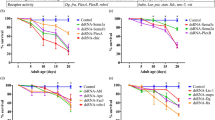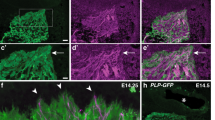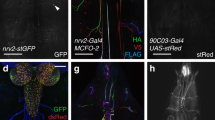Abstract
During embryonic development, neuronal growth cones traverse long distances along stereotyped pathways to arrive at their appropriate targets. Since Harrison's initial observations1, increasing evidence has supported the notion that axonal pathways are “pioneered” early in development when the distances are short and the terrain relatively simple; thus an axonal scaffold is erected upon which later neurones can navigate. Grasshopper embryos have emerged as an attractive preparation in which to study pathfinding because the nervous system is relatively simple, and the individual identified neurones in the periphery and central nervous system (CNS) of the embryo are large and highly accessible. How are the first axonal pathways established between the periphery and CNS? Bate2 has described a single pair of cells in the limb buds, and two pairs in the antennae, which were thought to establish the very first peripheral pathways over distances of several hundred micrometres from the periphery to CNS; he called these pairs of cells ‘pioneer neurones’. Keshishian3 confirmed this finding and also described4 a second pair of pioneers in the limb buds. We report here a further analysis of peripheral pathfinding in the grasshopper embryo using a monoclonal antibody, called I-5, which stains the cells responsible for establishing the first pathways5,6. In contrast to the earlier reports, we find a large array of peripheral cells responsible for establishing the first pathways, with both pathfinders and landmark cells spaced at short intervals along the route. Furthermore, growth cones from central motoneurones make important contributions to the first peripheral pathways6.
This is a preview of subscription content, access via your institution
Access options
Subscribe to this journal
Receive 51 print issues and online access
$199.00 per year
only $3.90 per issue
Buy this article
- Purchase on Springer Link
- Instant access to full article PDF
Prices may be subject to local taxes which are calculated during checkout
Similar content being viewed by others
References
Harrison, R. G. J. exp. Zool. 9, 787–846 (1910).
Bate, C. M. Nature 260, 54–56 (1976).
Keshishian, H. Devl Biol. 80, 388–397 (1980).
Keshishian, H. & Bentley, D. Soc. Neurosci. 7, 347 (1981).
Chang, S., Ho, R., Raper, J. A. & Goodman, C. S. Soc. Neurosci. 7, 347 (1981).
Ho, R., Chang, S. & Goodman, C. S. Soc. Neurosci. 7, 348 (1981).
Goodman, C. S. & Spitzer, N. C. Nature 280, 208–214 (1979).
Goodman, C. S., O'Shea, M., McCaman, R. E. & Spitzer, N. C. Science 204, 1219–1222 (1979).
Stewart, W. W. Cell 14, 741–759 (1978).
Taghert, P., Bastiani, M., Ho, R. K. & Goodman, C. S. Cell (submitted).
Raper, J. A. & Goodman, C. S. Soc. Neurosci. 7, 347 (1981).
Goodman, C. S., Raper, J. A., Ho, R. & Chang, S. 40th Symp. Soc. dev. Biol. (in the press).
Raper, J. A., Bastiani, M. & Goodman, C. S. J. Neurosci. (in the press).
Raper, J. A., Bastiani, M. & Goodman, C. S. J. Neurosci. (in the press).
Bate, C. M. & Grunewald, E. B. J. Embryol. Exp. Morphol. 61, 317–330 (1981).
Author information
Authors and Affiliations
Rights and permissions
About this article
Cite this article
Ho, R., Goodman, C. Peripheral pathways are pioneered by an array of central and peripheral neurones in grasshopper embryos. Nature 297, 404–406 (1982). https://doi.org/10.1038/297404a0
Received:
Accepted:
Issue Date:
DOI: https://doi.org/10.1038/297404a0
This article is cited by
-
Central projections from Johnston’s organ in the locust: Axogenesis and brain neuroarchitecture
Development Genes and Evolution (2023)
-
Scanning laser optical tomography resolves developmental neurotoxic effects on pioneer neurons
Scientific Reports (2020)
-
Epithelial domains and the primordial antennal nervous system of the embryonic grasshopper Schistocerca gregaria
Invertebrate Neuroscience (2020)
-
Dysregulation of axogenesis in the antennal nervous system of the embryonic grasshopper Schistocerca gregaria
Invertebrate Neuroscience (2019)
-
Patterns of cell death in the embryonic antenna of the grasshopper Schistocerca gregaria
Development Genes and Evolution (2018)
Comments
By submitting a comment you agree to abide by our Terms and Community Guidelines. If you find something abusive or that does not comply with our terms or guidelines please flag it as inappropriate.



